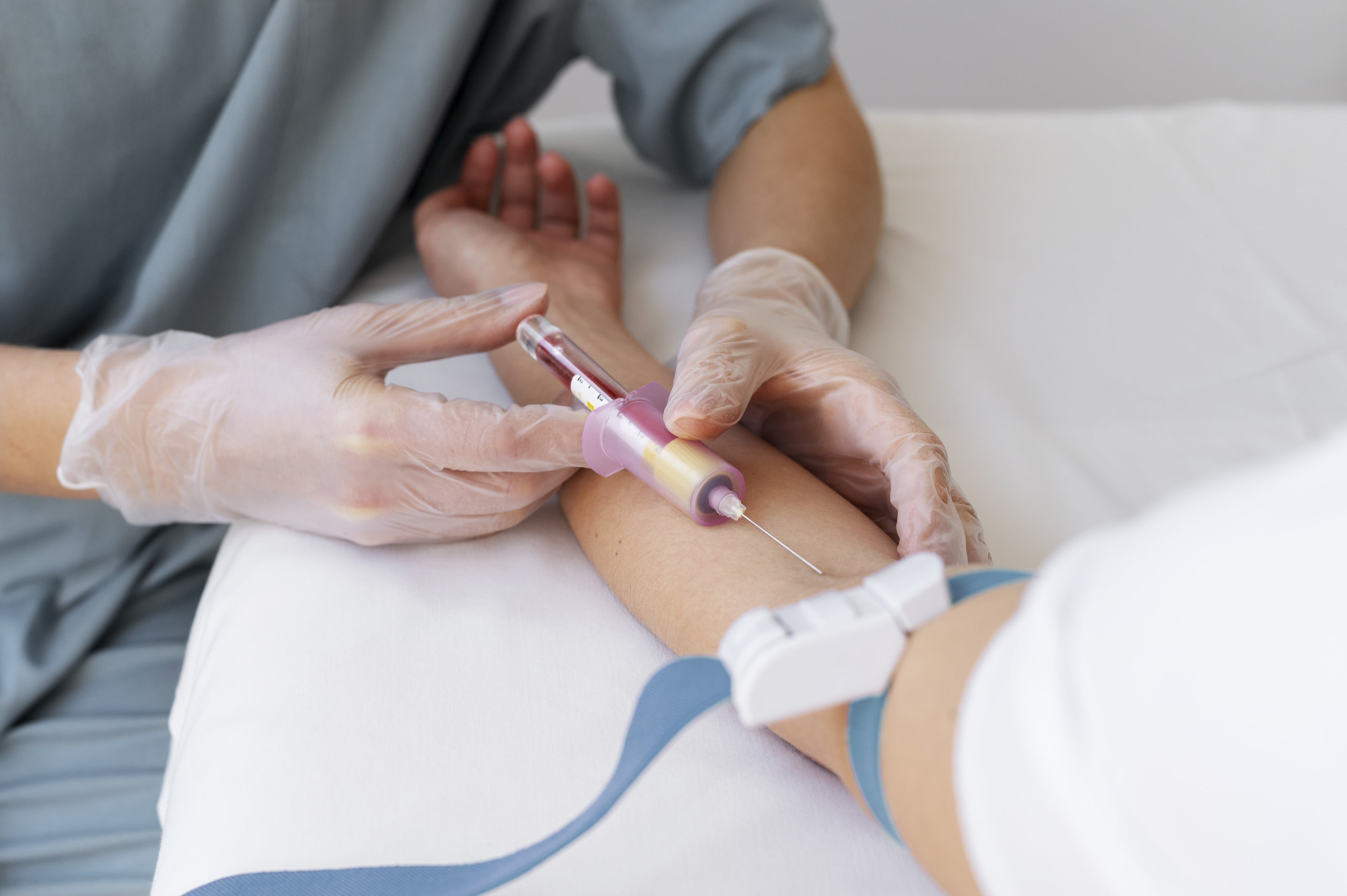
 Instagram
Instagram
MCHC Blood Test Results: Meaning of Low and High Levels


Related products
The mean corpuscular haemoglobin concentration (MCHC) test measures the haemoglobin concentration in a specific volume of the packed red blood cells (RBCs). Haemoglobin is an iron-containing carrier protein that transports oxygen from the lungs to the different body parts and is responsible for the red colour of the blood.
The MCHC test is one of the red cell indices that are part of the complete blood count (CBC) and, in combination with other tests, provides a presumptive diagnosis of anaemia. The MCHC relates to the size of the cells and is measured in g/ dL or g/ L. The customarily expected values are 340 ± 20 g/L or 34 ± 2 g/dL. The higher and lower values indicate different types of anaemia and other health conditions, and the doctors recommend further tests for definitive diagnosis.

For more information and in-depth understanding, visit our informative Red Blood Cell and Haemoglobin pages.
Why is the MCHC test performed?
The MCHC test measures the concentration of haemoglobin (Hb) in a given volume of packed red corpuscles (RBCs). As Hb is the primary oxygen-carrying protein, the MCHC test is, in fact, a measure of the oxygen-carrying capacity of the blood. The test is performed routinely as a part of a complete blood count (CBC) and is used for routine health screening, diagnosis of illnesses, monitoring and follow-up of treatment regimes, etc. To get a broader picture of your metabolic and endocrine health, the Advanced Thyroid Function Blood Test can be useful. Thyroid dysfunction can indirectly influence red cell production and oxygen transport, making it a relevant companion test to CBC.
The healthcare providers recommend the MCHC test for the following conditions:
- Anaemia: The symptoms of anaemia, e.g., pale skin, lightheadedness, fatigue, weakness, shortness of breath, chest pain, irregular heartbeat, cold extremities and dizziness.
- Diagnosis: In patients with anaemia, the doctors often ask for an MCHC test to know the type of anaemia. For example, iron deficiency anaemia causes a decrease in MCHC value, while hemolytic anaemia causes an increase in MCHC values.
- Hemoglobinopathies: The MCHC test is used for the monitoring of diseases that disturb the structure and functions of haemoglobin, e.g., thalassemia and sickle cell anaemia.
- Diagnosis and monitoring of blood disorders: Abnormal MCHC values are observed in various blood disorders, e.g., hereditary elliptocytosis and spherocytosis. The routine MCHC test is recommended to monitor the response to different treatments.
If you're interested in exploring more diagnostic options to get a full health picture, check out our All Health Tests Collection, which includes a wide array of at-home kits suitable for various conditions and health goals.

The procedure of the MCHC test
For the test, the pathologist or the laboratory staff draws a small amount of blood into the test tubes. The process is performed at clinics or hospitals, and no activity or dietary restrictions are necessary. The skin puncturing causes a slight pain. The rest of the procedure is without any complications.
In modern labs, automated haematology analyzers are available to measure all haematological parameters, including hematocrit and haemoglobin concentration. The MCHC is calculated by dividing haemoglobin concentration with the hematocrit and multiplying with 100 to get results in percentages.
People taking blood thinners or having bleeding disorders experience prolonged bleeding. Sometimes, a large bruise or haematoma develops at the collection site that causes discomfort, but it is rare. Another potential complication is the risk of infection at the puncture site.
Welzo offers a Full Blood Count (FBC) Test Kit to determine different blood parameters thoroughly. The results are highly accurate and quick. Visit the page to order the kit.
Results and their interpretations
The results can either be within the reference range or higher or lower. The results within the reference range of 340 ± 20 g/L or 34 ± 2 g/dL means everything is fine, and the blood has adequate concentration of haemoglobin. To assess iron status specifically, the Ferritin Blood Test is highly recommended. Ferritin reflects the body's iron stores and is often the first marker to change in iron deficiency.
Low values
The low value of MCHC or hypochromia means the concentration of haemoglobin and, thus, the oxygen-carrying capacity of the blood is less than the optimal value. The major causes responsible for low MCHC values are;
- Iron deficiency anaemia: The body needs iron to produce haemoglobin. If enough iron is not available, the body doesn’t produce enough haemoglobin, resulting in paler and smaller red cells with lower haemoglobin concentration.
- Chronic illnesses: Several chronic illnesses negatively influence the production of haemoglobin and red cells, causing low MCHC. These include chronic inflammatory conditions, e.g., inflammatory bowel disease, rheumatoid arthritis and chronic kidney disease.
- Blood disorders: Various blood disorders, such as thalassemias (alpha, beta, and intermedia), sideroblastic anaemia lea, poisoning, etc., cause lower than expected MCHC values. A lower MCHC value in the absence of anaemia represents a poor prognosis in the patients in the ICU.

High MCHC value
Higher values or hyperchromia means haemoglobin concentration in the red cells is higher than usual. Several causes responsible for higher MCHC values are;
- False increases in the MCHC value due to cold agglutinin disease (CAD): It is a rare autoimmune condition in which the body's immune system identifies the red cells as foreign agents and attacks them.
- Autoimmune haemolytic anaemia: It develops due to autoimmune conditions, using certain medications, e.g., penicillin, methyldopa, cephalosporins and chemotherapy drugs, infections, genetic factors etc.
- Other causes: Other causes of higher MCHC are liver diseases, severe burns, hyperthyroidism, hereditary spherocytosis, haemoglobin C disease and sickle cell disease (homozygous).
The lower or higher values don't necessarily mean anaemia, as there are several types of normochromic anaemia in which the MCHC values are normal. These include many types of haemolytic anaemia, bone marrow failures, mixed anaemias, anaemia due to renal diseases and blood loss anaemia. For individuals under stress or suspected adrenal imbalance, the Cortisol Blood Test can provide further insight. Elevated cortisol levels may impact overall blood composition and hydration, which could influence MCHC readings. Medications such as penicillins, NSAIDs, and chemotherapy drugs can lead to increased MCHC by altering blood cell characteristics. Discussing medication history with your healthcare provider is essential for accurate interpretation. Individuals concerned about liver-related causes of elevated MCHC may benefit from a Bilirubin Blood Test. It assesses liver function and can help determine whether hyperchromia stems from hepatic issues. If performance, recovery, or nutritional absorption is a concern, explore the Sports Performance Tests Collection. These tests assess factors that affect athletic endurance, recovery, and metabolic efficiency—many of which are indirectly linked to blood quality and oxygenation. Additionally, symptoms like hair loss, fatigue, and mood changes could relate to hormonal imbalances, which also affect red blood cell health. In this case, the AMH Blood Test is useful for reproductive and hormonal health evaluations, especially in women experiencing these overlapping symptoms.
Frequently Asked Questions
How can one increase the MCHC value in the blood?
To boost the MCHC values, taking a dietary supplement containing iron is critical. The other option is to diversify the meals by including beans, leafy greens, lentils, and lean meats. The treatment of underlying chronic diseases and inflammations is necessary. In acute and life-threatening conditions, blood transfusion is necessary.
Does dehydration influence MCHC values?
Yes, dehydration causes an apparent increase in the MCHC value. This is due to the reduction in blood plasma volume and the redistribution of water and fluids into the tissues and cells that need it the most.
How low does MCH be treated?
For the treatment of MCHC, medications, dietary supplements, dietary changes, and procedures, e.g., blood transfusion and hydration (fluid therapy), are used. The untreated and chronic cases of lower MCHC result in severe complications like hypoxia anaemia, paleness, heart palpitations and worsening of underlying health conditions.
What medications cause an increase in the MCHC values?
Several medications that cause increased MCHC due to disturbance of fluid dynamics of the blood are penicillins, nitrofurantoin, non-steroidal anti-inflammatory drugs (NSAIDs), methyldopa, levofloxacin, Levodopa and cephalosporin antibiotics. The responses vary from person to person, and discussing the matter with the healthcare provider is critical.
What are the symptoms of higher MCHC values?
The symptoms depend upon the cause of higher MCHC. For example, if the cause is liver disease, the symptoms are yellowish skin, fatigue, poor appetite, and pain in the upper part of the abdomen. If it is due to dehydration, the symptoms are thirst, dry skin, dry mouth, decreased urine output, dark-coloured urine and dizziness.
What are the symptoms of lower MCHC values?
Lower MCHC or hypochromia is often a sign of thalassemia and different types of anaemia. The symptoms depend upon the underlying causes. The general symptoms are fatigue, weakness, paleness of skin and mucous membranes, shortness of breath, dizziness, lightheadedness, irregular and rapid heartbeat, cold feet, hands and extremities, poor cognitive functions and hair loss.
What is the difference between MCHC and MCH?
The mean corpuscular haemoglobin (MCH) test measures each red blood cell's average amount of haemoglobin. It is calculated by dividing the total amount of haemoglobin in the blood by the number of red blood cells. It is measured in picograms (pg) of haemoglobin per red blood cell, and the average value is 29 ± 2 picograms (pg) per cell.
The MCHC, on the other hand, measures the haemoglobin concentration in a specific volume of the packed red blood cells (RBCs) and is measured in g/ L or g/ dL.

Summary
The mean corpuscular haemoglobin concentration (MCHC) is a quantitative measure of the haemoglobin concentration in the blood's red cells. It is included in the complete blood count (CBC) test alongside the other tests, e.g., RBC count, WBC count, haemoglobin concentration, platelet count, differential white cell count, etc.
The reference range is 340 ± 20 g/L or 34 ± 2 g/dL, and higher or lower values indicate some types of anaemia, thalassemia and other health conditions. The doctors, however, view the results in light of other tests in the CBC for a better understanding of the causes of anaemia and the causes and prognosis of higher or lower MCHC values in the absence of anaemia. There is always a risk of error in the results, and the proper explanation demands caution and understanding of its limitations and potential errors in the test. The findings must be considered only if other tests support them and are repeatable.

Our article, ‘Blood Tests: Definition, Importance, Uses, and Types,’ provides a detailed overview of the blood work. Visit the page to read it and understand the dynamics of blood.















 Rated Excellent by 14,617+ Reviews
Rated Excellent by 14,617+ Reviews